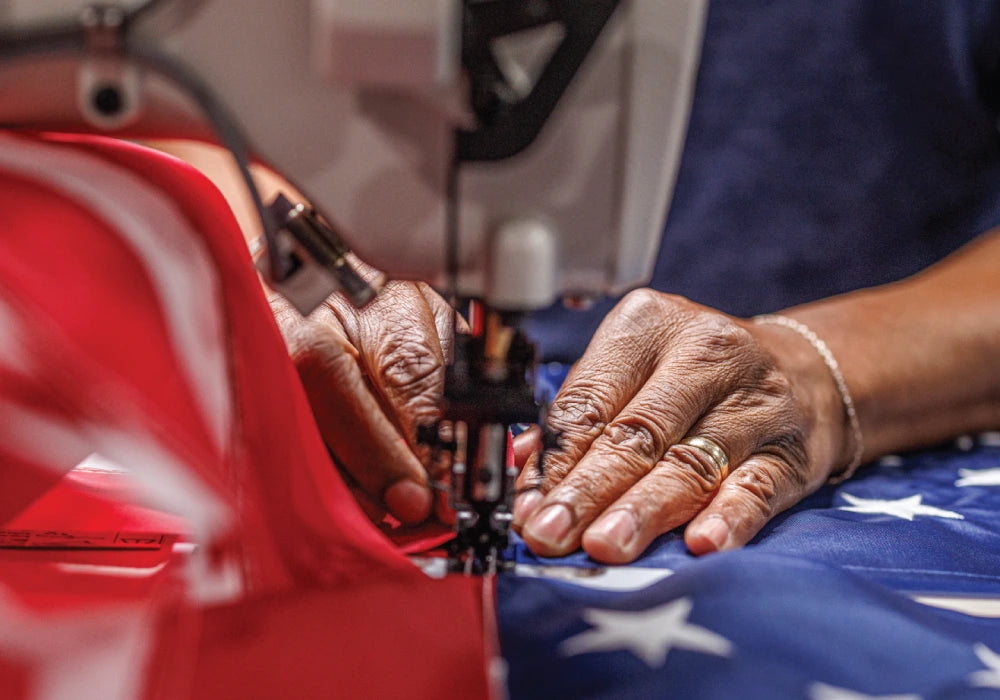The American flag is more than just a piece of cloth—it represents freedom, unity, and sacrifice. Every detail in its design holds deep meaning. The 13 stripes represent the original colonies, while the 50 stars symbolize the current states in the union. Its proportions and layout are not accidental; they are carefully designed to maintain a strong and consistent symbol of national pride. These features influence how American flag dimensions are standardized, especially when preserving the flag’s powerful message in every setting, from classrooms to national monuments.
The History Behind American Flag Standards
Evolution of the Flag’s Design
The American flag's design has changed many times since its first official adoption in 1777. Created with 13 stars and 13 stripes to represent the original colonies, the flag’s layout adapted as the nation grew. Every time a new state joined the Union, the stars were updated to reflect this addition. However, the stripes were eventually fixed at 13 to honor the founding states. Understanding this evolution is key to recognizing how the United States flag's history connects to national identity and design standards. Each addition to the Union brought a new star to the flag, but it wasn’t always an instant change. Updates were typically made on July 4 following a state’s admission. The arrangement of stars shifted through various formations—circles, rows, and staggered patterns—before settling on the current design of nine rows alternating five and six stars. Meanwhile, the stripe proportions remained discussed until they were formally standardized. These ongoing adjustments contributed to the development of the consistent American flag dimensions recognized today.
The Role of the Flag Code
In 1942, Congress passed the United States Flag Code to ensure uniformity in how the flag is displayed and treated. This code laid out guidelines for proportions, positioning, and handling practices. Though it isn't enforceable by law, it plays a major role in promoting flag respect and consistency. Prior to this, flag dimensions varied by manufacturer, leading to mismatches in star placements or stripe widths. With the Flag Code in place, there was now an accepted model for U.S. flag dimensions in all contexts—public, private, and ceremonial.
Key Milestones in U.S. Flag Design Regulations
The 1912 executive order by President Taft was the first to set official proportions and star arrangements. Later, President Eisenhower’s 1959 order adjusted the design to accommodate Alaska and Hawaii. These government-led updates created consistency across military, government, and civilian use. Such milestones weren’t just cosmetic—they defined how the flag should appear in every scenario.
Official U.S. Flag Dimensions and Proportions

Standard Height-to-Width Ratios
The ratio between the height and width of a flag determines how it will look when flown, hung, or folded. Here's a guide:
- 1:1.9 – This specific ratio comes from Executive Order 10834, issued in 1959 by President Eisenhower, which standardized flag specifications, including star arrangement and proportions. The flags flown at federal buildings, military installations, or official ceremonies follow this exact height-to-width ratio. The elongated horizontal shape of the flag ensures the stars and stripes maintain their intended layout, offering clear visibility from a distance and a majestic appearance while flying. Additionally, flags of this ratio often exhibit optimal movement in the wind, giving a dynamic and graceful impression. This ratio upholds tradition, compliance, and respect for national symbols, making it the most recognized and accepted standard in federal and state-level institutions. F
- 2:3 – It is frequently chosen for decorative purposes where wall space, pole height, or frame dimensions might not accommodate longer flags. Retail stores often stock 2:3 flags because they fit more naturally on display racks, garden poles, or as wall décor. This ratio maintains the general proportions of the stars and stripes, ensuring the flag’s appearance remains recognizable and dignified, even if not entirely traditional. For businesses, schools, or homeowners who want an American flag without needing the exact government ratio, 2:3 provides flexibility without sacrificing aesthetic appeal.
- 3:5 – The 3:5 ratio balances official design and practical display, making it one of the most popular formats for household flags. The shape is well-suited to home flagpoles, porch mounts, and casual outdoor displays, offering a recognizable silhouette without the extended length of government-standard flags. This ratio ensures that the flag’s elements remain proportionally attractive even when viewed from close up or while stationary. Its broader width compared to its height provides an elegant drape and flowing motion when flown, making it a favorite for patriotic homeowners. Available widely through brick-and-mortar and online retailers, 3:5 flags cater to a broad audience seeking a respectful yet practical way to display national pride. The ratio is also common in promotional and educational events due to its versatile size and ability to fit various mounting systems.
- 5:8 – Some designers or institutions prefer this ratio for aesthetic reasons, especially when the flag is meant to cover larger wall spaces or be incorporated into broader interior design themes. It’s also occasionally used for display on vertical flagpoles where a longer flag enhances visual prominence. Although not governed by official mandates, the 5:8 proportion offers a unique take on classic American flag sizes while preserving the visual integrity of its symbols. For collectors, decorators, or event planners seeking a nonstandard but still respectful flag shape, the 5:8 format introduces variety without compromising identity.
- 1:2 – With its distinctly elongated shape, the 1:2 ratio diverges from traditional flag proportions and finds its use mostly in banners or stylized displays. This format results in a highly horizontal flag, often used in promotional events, parades, or custom installations, emphasizing striking visibility rather than strict adherence to protocol. While not standard for official or residential flag use, the 1:2 ratio can create a commanding visual presence, particularly when mounted across wide spaces such as fences, stage backdrops, or building facades.
Comprehending these differences ensures the flag honors its symbolic meaning and suits the environment in which it proudly waves.
Dimensions of the Union (Blue Field) and Star Placement
The union, also called the canton or blue field, holds the white stars representing the 50 states. It occupies the upper left corner of the flag when displayed horizontally. The union’s height is exactly seven-thirteenths of the overall flag height, and its width spans 40% of the flag’s total length. The stars are arranged in nine horizontal rows, alternating five and six stars, all aligned in precise vertical and horizontal spacing.
Stripe Width, Color Specifications, and Material Guidelines
Each stripe is of equal width, making up one-thirteenth of the total flag height. The red used is officially referred to as “Old Glory Red,” while the blue in the union is called “Old Glory Blue.” These colors are standardized using the Standard Color Reference of America. When producing made-in-USA flags, materials like nylon, polyester, or cotton are commonly used, depending on durability needs and display location. Fabric choice plays a big role in how the flag drapes, resists weather, and maintains vibrancy over time.
Adhering to the Flag Code for Proper Sizing
A 3x5-foot flag is considered the standard for most outdoor poles, while larger flags require proportionate poles for support. Ignoring these guidelines can make flags appear awkward, oversized, or even disrespectful. Following the Flag Code helps ensure respectful, accurate displays, whether you're flying a small banner at home or raising a large American flag on a public pole.
Comprehensive American Flag Size Chart

Small and Miniature American Flags
These compact options are highly versatile and can be used in both educational and ceremonial settings. When attached to handheld sticks or mounted on small poles, these flags allow for personal or symbolic representation of patriotism. Whether used as decorations or tokens of respect, mini American flags often serve a specific, intentional role. Despite their small size, these flags must still follow proportion guidelines to maintain authenticity in design and symbolism.
Monumental Flags
Flags of monumental proportions are typically reserved for use in major public venues such as stadiums, military bases, or national parks. These massive displays are engineered with specialized materials to withstand heavy winds and harsh outdoor conditions. Their scale commands attention and fosters a sense of collective identity during public events or ceremonies.
Choosing the Right Flag for Your Setting
Flagpole Height
The relationship between the flag size for home display and pole height is essential for a balanced and stable display. A flag that’s too large for a short pole can droop, making it difficult to read or appreciate, while one that’s too small on a tall pole may seem lost or insignificant. As a general rule, the flag's length should be about one-quarter to one-third the height of the pole. This ensures the flag flies freely and looks visually proportional. Those looking to fly a flag-size chart standard at home should match the dimensions carefully to avoid improper presentation.
Specialty Flags
These historical American flags occupy a unique place in American culture. They represent specific moments in history or serve particular functions during events. Here are some examples:
- Betsy Ross Flag – Characterized by its 13 five-pointed stars arranged in a circle and 13 alternating red and white stripes, this flag represents the original 13 colonies that declared independence from British rule. Though historical debates persist over the exact origins of the flag and Betsy Ross’s role in its creation, it remains a potent emblem of unity and early American resilience. Educational institutions frequently use the Betsy Ross flag in classrooms and during Independence Day celebrations to teach students about the Revolutionary era. Historical societies and reenactment groups also incorporate it into their events to authentically depict the early struggle for independence. Beyond educational purposes, the flag is also seen at parades, patriotic ceremonies, clothing, and memorabilia, reinforcing its continued relevance.
- 15-Star Flag – Also known as the Star-Spangled Banner, the 15-star flag holds a revered place in American history due to its association with the War of 1812. This version of the flag featured 15 stars and 15 stripes, reflecting the admission of Vermont and Kentucky to the Union. Its most famous moment came during the Battle of Fort McHenry in 1814, when Francis Scott Key, witnessing the flag still flying after a night of relentless British bombardment, was inspired to write a poem that would become the U.S. national anthem. This flag’s legacy continues in the original preserved at the Smithsonian’s National Museum of American History. It is frequently replicated for historical reenactments, museum exhibitions, and commemorative events tied to American music or military pride.
- 24-Star Flag – This flag flew during a transformative period in the 19th century, characterized by westward movement, industrial progress, and increased emphasis on national identity. Historical reenactors often use the 24-star flag to authentically portray events from the Jacksonian era, such as early political rallies, frontier expeditions, and military actions. The flag maintains the traditional arrangement of stars and stripes, but with an increased star count that captures the momentum of national growth. Museums and educational programs use this flag to illustrate how the U.S. adapted its symbols to reflect new realities and how the flag evolved alongside the nation’s borders and people.
- Military Burial Flag – The military burial flag stands as one of the most solemn and respectful symbols of national gratitude. Traditionally made in the official 1:1.9 ratio and featuring embroidered stars, this ceremonial flag is presented to the next of kin of a deceased service member during military funerals. Folded meticulously into a triangle with only the blue field and white stars visible, the flag represents the service, sacrifice, and honor of the individual who served the United States. Each fold during the ceremony holds symbolic meaning, and words of thanks from a representative of the armed forces typically accompany the presentation. These flags are never flown but kept by families as a cherished memorial. The burial flag is central to military funerals conducted under the guidelines of the Department of Veterans Affairs and is often accompanied by a three-volley salute and the playing of Taps. Its presence transforms a burial into a powerful act of national recognition, ensuring that the legacy of service continues beyond a soldier’s life.
- Inaugural Flag – While its specific design may vary depending on the administration and the traditions of the time, inaugural flags typically include the traditional stars and stripes and may be adorned with the seal of the President or other patriotic elements. These flags are displayed prominently during inaugural parades, at the U.S. Capitol, and often appear in official photographs and commemorative memorabilia. Their use underscores the legitimacy and continuity of American leadership, reinforcing the democratic process in visual form. Collectors usually seek out inaugural flags as keepsakes, and historians use them to study the evolving visual language of political pageantry.
Displayed with purpose, these specialty flags bridge the past and present, inviting reflection while preserving the nation’s legacy.
Buying and Maintaining American Flags

How to Purchase U.S. Flags Online
Finding the right vendor to obtain a flag involves more than just browsing for the best price. Reputable sellers offer detailed information about fabric quality, dimensions, and compliance with display guidelines. Whether visiting a local store or using an online platform, verifying that the flags meet national specifications is important. Checking customer reviews, return policies, and origin labeling helps ensure a trustworthy purchase. Many choose to purchase small American flags from companies that specialize in patriotic merchandise because these sources often offer greater craftsmanship.
What to Look for in Made-in-USA Flags
Materials are carefully selected for durability and fade resistance, and stitching is reinforced to withstand outdoor elements. Common U.S. flag sizes is typically produced under strict guidelines, ensuring it aligns with traditional flag etiquette and proportions. Shoppers should look for certifications that confirm domestic manufacturing, mainly when flags are intended for public or ceremonial display.
The American flag’s story is interwoven with national milestones, making each version of it part of a broader narrative. Displaying it with intention means acknowledging that legacy and continuing its message through respectful presentation. It isn’t merely about following rules but deepening one’s connection to the flag’s meaning. Whether someone chooses to buy large American flags for a public event or a small version for a personal moment, doing so with understanding transforms a simple gesture into a lasting tribute.






